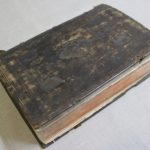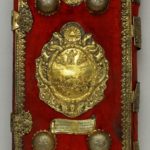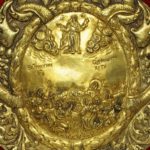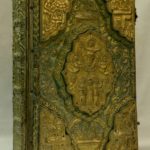The Ascension of the Lord is one of the greatest and most ancient Christian holidays, which is among the twelfth. This holiday is transitional, that is, it does not have a fixed date, and it depends on what day Easter falls on. The Ascension is celebrated on the 40th day after Easter and always falls on a Thursday. On this day, an event from New Testament history is remembered, which is described in the Gospel and in the book of Acts of the Holy Apostles. The general holiday cycle of the Ascension includes 10 days - 1 holy day, own holiday on Thursday and 8 days after the holiday.
The Holy Scriptures tell, that Jesus Christ led the apostles out of Jerusalem to Mount Eleon and, raising his hands, gave them a blessing, and then began to move away from them and ascend to the sky.
The liturgical Gospel and the Apostle at the exhibition
"Historical Sketches. Much in little / big in small"
The museum's collection of old prints contains liturgical books in which we find the hymnography and iconography of this holiday. Liturgical texts of the Ascension are found in the book Triod Tsvitna. Triod from the Greek language means three-song (τρία – “three” and ᾠδά – “song”), since it mainly contains canons of three songs. The Flower Triad is the second part of the Triad book. The first is called the Triodya Song. The name Tsvitna Triod comes from the feast of the Lord's Entry into Jerusalem, which is also called Palm Sunday. The liturgical texts in this book begin with the Lazarus Saturday service, which is closely related to the feast of the Lord's Entry into Jerusalem.
В Чернігівському історичному музеї імені В.В. Triod Tsvitna is kept by Tarnovsky (inv. No. Al-352)[1] printed in 1642 year in Lviv. This book was published in the printing house of a talented 17th century printer. Михайла Сльозки. The book is decorated with wonderful engravings, including the plot of the Ascension of the Lord. The following composition is presented: mandorla[2] with Christ in the rays of glory, that ascends is held by two angels, from below on Mount Eleonskaya stand the Mother of God and 12 briskly gesticulating apostles, between them are two other angels, pointing to the Savior.
Previously, this book was prayed in the church in honor of Archangel Michael in Novy Sanzhar (Poltava Region), and later in the church of Saints Cosmas and Damian in the village of Obolonia, Krolevetsky District (now Novgorod-Siversky district), "The Tale of Barlaam and Joasaph" was the topic of Ivan Franko's doctoral dissertation. The museum copy has traces of active use of the book - the pages are covered with wax.
Excellent in details, but we also find an exquisite engraving of the Ascension in the collection of sermons of Chernihiv Archbishop Lazar Baranovych "Trumpets for the Days..." (inv. №. Al-966)[1] 1674 year of publication (printing house of the Kyiv-Pechersk Lavra). The engraving precedes the words of the Chernihiv bishop "on the Ascension of our Lord God and Savior Jesus Christ". The poses and gestures of the Mother of God with the apostles differ from the previous print. The Virgin looks up. The apostles reverently bowed their heads. In the center of the icon, words from the Gospel of Luke are written in a wavy ribbon: "Ascend to heaven and worship Him". There are no figures of angels. Above, a rare element for the iconography of the holiday - an eagle - a symbol of the Ascension of Christ. Above it is the inscription in the ribbon "The Ascension of the Lord". The book belonged to the Savior-Transfiguration Men's Monastery in Maksakiv, as evidenced by the entry in it.
On a silver and gilded cover of the enthroned Gospel (inv. No. Al-210)[1] works of an unknown Ukrainian master, namely, on the middle of the lower board, the plot of the Feast of the Ascension is engraved. Here we see a slightly smaller number of figures of the apostles. The Mother of God is depicted in a kneeling pose on the Mount of Olives 7 apostles. Obviously, their number is smaller due to the complexity of the imaging technique. There are no figures of angels. It is known from the inset inscription, that this Gospel was a gift from Bunchuk's comrade Vasyl Polubotko 22 February 1765 year to Chernihiv Ascension Church, the founder of which was his grandfather - colonel and commanding hetman Pavlo Polubotok.
The plot "The Ascension of the Lord" is also depicted on the middle of the front panel of another Gospel (inv. № Al-215)[1] з музейної колекції. Among the figures is the Mother of God, two apostles and 4 angels. Christ sits on the throne, in the rays of glory. Under the feet of the Savior is a cherub.
Frame of the end of the 17th - beginning of the 18th century. enshrined in the Gospels 1771 year from the printing house of the Kiev-Pechersk Lavra. Most likely, the salary older than the book itself was taken from an old worn-out book. According to its artistic features, it can be attributed to the works of Ukrainian goldsmiths. The boards of the frame are covered with silver embossed plates with gilding.
The depiction of the Ascension of the Lord in museum old prints demonstrates not only the talent of Ukrainian xylographers and goldsmiths, but they also fulfill their main function - they reveal the deep meaning of this holiday and convey the joy of the gospel preaching.
Старший науковий співробітник музею,
candidate of theology Myroslav Mai-Boroda
[1] There only. С. 103-104
[1] Anna Arendar. Silver salaries of the Gospels of the XVII-XIX centuries from the collection of the Chernihiv Historical Museum named after V.V.. Tarnovsky. К.: Kyiv Dome Society, 2021. С. 182-183
[1] There only. С. 23
[1] Collection Cyrillic old collection of Chernihiv Historical Museum. В.В.Тарновського: Catalog / Compilers S.O. Polovnikova, І.М. Ситий. К., 1998. С. 66-67
[2] Mandorla is a special form of nimbus, oval-shaped glow.






















More Stories
Results 2025 year
Exhibition “Witnesses last. Memorial furniture of the 16th century, XVIII, ХІХ ст.”
Congratulations to dear Vera Zaychenko!